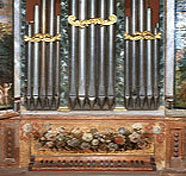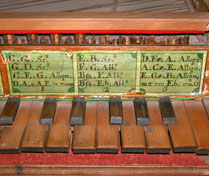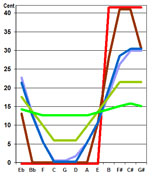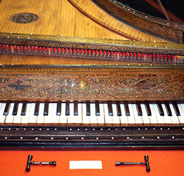Online recordings with unequal temperaments
Searching the internet—and especially YouTube.com—for either “unequal temperament” or “meantone” produces many hits, although only a few are really interesting. The following are recommended:
- A piece in 13th-century style. This has been recorded by medieval music scholar Margo Schulter using Pythagorean intonation: note the “serene” pure fifths and the “tense” dissonant major thirds.
- Frescobaldi's fragment from Cento Partite sopra Passacagli in Standard Meantone with Split Sharps. Starting in 4:47, Richard Lester explains the benefits and limitations of meantone.
He then shows the split keys on an extant harpsichord built by Doni in 1619. Lester then demonstrates the meantone “wolves” that arise if some fragments from Frescobaldi's Cento Partite sopra Passacagli are played on a normal keyboard tuned in meantone: finally he shows how the “wolves” are resolved by using the additional accidentals available thanks to the split sharps.
(This video is no longer there: we hope to find it reinstated soon). - Frescobaldi's Cento Partite sopra Passacagli in Standard Meantone with Split Sharps.
Played by Sara-Anne Churchill on a harpsichord built by Robert Hicks after Carlo Grimaldi (1703), with split accidentals (D sharp/E flat and G sharp/A flat), tuned in 1/4 syntonic-comma meantone.
- Pachelbel's Aria Sebaldina variations in Standard Meantone and Equal Temperament.
Each variation is first played transposed to g minor, which fits quite well a meantone temperament with the usual wolf location, then in the original f minor, where the very discordant wolf major thirds are heard. It is apparent that this and other works of Pachelbel require a circular temperament. - Introduction to unequal temperaments in F Sharp. David Pitches introduces the various unequal temperaments playing, on an electronic sampler organ, a piece unsuitable for Meantone. Here we hear temperaments in the following order: Meantone, d'Alembert, Vallotti, Kirnberger and Kellner.
- An organ masterclass with reeds and tierces in meantone. A student plays the organ in Hammerwood Park.
- J.S. Bach's Dorian Fugue in meantone. This interesting performance by Mark Shepherd shows how some organ works by Bach are to some extent compatible with meantone temperament, still very common in church organs in Bach's time. Note however the awful discords in 4:07, 4:39 and later also: together with many other features of the score, they clearly show that this work was composed for a circular temperament.
- A few fragments recorded in different unequal temperaments in harpsichord recitals
by C. Di Veroli. Please note that the choice of temperament was dictated by the prevalent repertoire of the recital: inevitably, the temperament is not the ideal one for a few pieces. - Pieces by François Couperin in Standard French (Rousseau's ordinaire) temperament
played by C. Di Veroli. Recital in Bray (Ireland) in 2011: Les Baricades Mistérieuses (B flat major), L'âme-en-peine (b minor), Les Fauvétes Plaintives (d minor). Rehearsal before a recital in Lucca (Italy) in 2016: Les Abeilles (g minor), Les Coucous Bénévoles (b minor), Les Ondes (A major).



